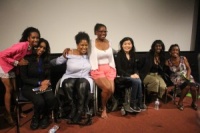Lauren Appelbaum
Hollywood Inclusion
(Black PR Wire) Los Angeles, California – “We’re going to demand change,” moderator Natalie Gross, Communication Coordinator for Inclusion in Hollywood, opened the Women of Color Disability Summit sponsored by Women of Color Unite and The JTC List Wednesday evening in Hollywood.
Gross was joined by five other women of color with disabilities talking about how to ensure women of color with disabilities are included in the entertainment industry.
“Getting a job out here is all about who you know,” Tatiana Lee, Hollywood Inclusionist at RespectAbility, as well as a model and actress with spina bifida who uses a wheelchair, said. “How can I do that if I literally cannot get in the room for networking events?”
Diana Elizabeth Jordan, an actress and director with cerebral palsy, said actors with disabilities need to have access to “rights that gives us equity, not an advantage.”
“An accessible dressing room is not a privilege. An ASL interpreter is not a privilege. A ramp is not a privilege. These are rights guaranteed to us under the Americans with Disabilities Act.”
However, she noted that many actors often do not ask for their rights for fear of being labelled as difficult.
Accurate Representation on Screen
Most of the panelists noted that they do not see themselves represented on screen.
“I would love to see people that look like me on TV but you don’t see it,” Stephanie Thomas, a disability fashion styling trailblazer who is a congenital amputee, noted. “I’m not a wheelchair user; I’m not disabled enough.”
Jordan and Lee discussed the issue that an overwhelming majority of characters with disabilities are played by actors without disabilities.
“If there was going to be blackface, the NAACP would be all over that,” Jordan noted to nodding in the audience. “Disability is not a trained skill. It is a life experience.”
Lee added, “It would be totally fine for anyone to play someone in a wheelchair if I was able to audition for and play any role.”
She recounted a story when she was picked for a commercial but later was let go when the production team realized she uses a wheelchair. “Production doesn’t want to use you,” she was told. “They want the shots to be uniform.”
“We don’t have to say the person is disabled,” Andrea Jennings, Founder of Shifting Creative Paradigms who has a TBI and spinal cord injury, added. Jennings often encourages writers to write a character with a disability but not specifically draw attention to the person’s disability – just show it.
Tackling Stigma
Talking about misconceptions and stereotypes, Gross, who is blind and uses a cane to get around, said, “People ask me who dressed me and I’m like me!”
“People are surprised when you are yourself,” Kaitlyn Yang, visual effects supervisor and founder of Alpha Studios, added. “People are surprised when wheelchair users drive. We do drive. That’s one of the reasons the handicap sticker was made.”
“Just because we are not doing one thing, it does not mean we are sitting around not doing anything else,” she added.
“People see us do things that don’t look ‘normal’ and assume we are in distress and immediately come over to help whether we need it or not,” Lee, who has spina bifida and uses a wheelchair, noted. “By you not asking us, you take away our independence to ask for help. We just need you to move away half the time.”
Thomas talked about living in two words. “When people look at me, immediately, they get that impression on their face – what is she doing up there?” But when they notice her missing digits, she said, “I still get the looks and people do treat you differently.”
All of the panelists talked about being resilient and how their disability gives them the creativity to approach problems in new ways.
Yang called the issues that people struggle with on set “is our norm.” For example, shipping a wheelchair is harder than items most production companies need to ship on a daily basis.
“I hear no and I just keep going,” Jordan said.
Working Toward the Future
Ultimately, to achieve inclusion, the panelists argued for a shift in mindset.
“Diversity is getting an invite to the party,” Jennings said. “Inclusion is being offered a seat.”
“It’s not enough to just put us on the list,” Yang added. “Are you actively advocating for diversity and inclusion participants?”
Cheryl Bedford, founder of Women of Color Unites & The JTC List, made a pledge at the end of the panel to do her part in ensuring inclusion of people with disabilities: “I’m only going to sit on a panel unless there is a disabled person also on the panel,” she promised. “We leave no marginalized group behind.”


